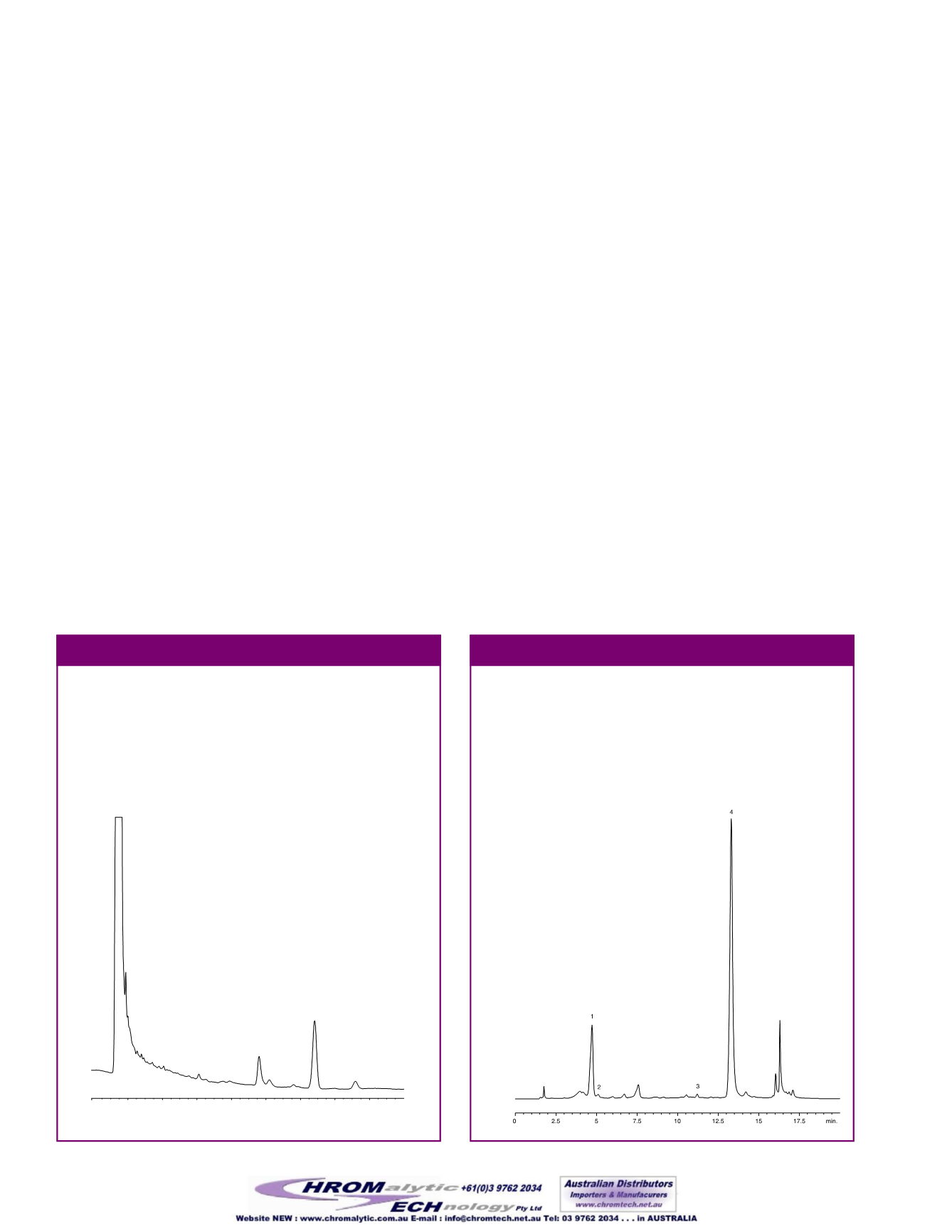
Restek Corporation • (800) 356-1688 • (814) 353-1300 •
raphy (TLC) also is used, primarily for the qualitative identifi-
cation of herbals and for purity evaluations. HPLC is used in
approximately 90% of the current methods formarker com-
pounds andmainly relies on a reversed phase separationwith
UV-VIS, refractive index or light-scattering detection. GC,
while not aswidely applicable, is very useful for the analysis of
volatilemarker compounds and residual solvents. For both
HPLC andGC botanical analyses, column reproducibility and
robustness is very important. RestekHPLC andGC columns are
able tomeet the demands of analyzing these complex systems.
HPLCAnalysis of Allicin inGarlic
Garlic, orAllium sativum, has the reported benefits of lowering
cholesterol, reducing hypertension, and acting as an antimicro-
bial agent in living systems. Garlic often is added to the diet as
garlic powder or garlic capsules. The active ingredients in gar-
lic are thought to be the sulfur-containing compounds, or thio-
sulfinates, present in the volatile oil.Alliin, which converts to
allicin (S-allyl-2-propenthiosulfinate) in the presence of the
enzyme alliinase, is present at about 1% in garlic cloves.
INAMethod 110.001—the analysis of allicin in garlic—is an
isocratic reversed phaseHPLC procedure using aC18 column,
withUVdetection at 240nm (Figure 1). Because allicin has
limited stability in solution, samples should be analyzed soon
after extracting into coldwater. In addition, the allicin reference
standard needs to be prepared by extracting the allicin from
garlic powder by solid phase extraction (SPE) and calculating
the concentration based on theUVabsorbance of the standard
solution.
HPLCAnalysis of Hyperforin inSt. John’sWort
St. John’swort, or Hypericum perforatum, is purported to ease
the symptoms ofmild depression, anxiety, and insomnia. The
active ingredient is thought to be hyperforin, although other
compoundsmight also contribute to the beneficial effects. St.
John’swort can be added to the diet in either capsule or tablet
form of the leaves, stems or flowers, or as an extract.
According to INAMethod 112.001—theHPLC analysis of
hyperforin and adhyperforin in St. John’swort—the samples
are extractedwithmethanol in an ultrasonic bath.
Chromatographic separation is performed on aC18 reversed
phase columnwith acetonitrile and phosphate buffer as the
mobile phase.After UVdetection at 270nm, the hyperforin and
adhyperforin are quantitated by comparison of the response of
these compounds to the response of a standard solution of
hyperforin. The analysis of a St. John’swort capsule using a
Pinnacle II™C18 column shows excellent peak shapes for the
active ingredients in this herbal product (Figure 2).
HPLCAnalysis of Phenolics inEchinacea
Echinacea, one of themost popular nutraceutical herbs, is
thought to enhance the immune system and act as an immune
stimulant against colds and flus. It can be taken in capsule or
tablet form, or used in the preparation of an herbal tea. The
active compounds in echinacea are thought to be caffeic acid
derivatives such as caftaric acid, cichoric acid, chlorogenic
acid, and echinacoside.
HPLC analysis of hyperforin and adhyperforin in St. John’sWort
capsule using aPinnacle II
™
C18 column shows excellent peak
shape for themarker compounds.
Figure 2
0
2
4
6
8
10
12
14
16 min.
1
2
Column
Pinnacle II C18
Catalog #: 9214565
Dimensions: 150mm x 4.6mm
Particle size: 5µm
Pore size: 110Å
Conditions
Mobile phase: acetonitrile:
0.01N phosphate buffer, pH 2.5 (85:15)
Flow: 1.2mL/min.
Temp.: 30°C, autosampler@ 15°C
Det.: UV@ 270nm
Sample
St. John'sWort capsule
Inj.: 20µL
Conc.: 4.17mg/mL capsule,
contents inmethanol
Peak list
1. hyperforin
2. adhyperforin
HPLC analysis of phenolic compounds in echinacea capsules
using aPinnacle II
™
C18 column achieves resolution
of four keymarker compounds.
Figure 3
LC_0175
Column
Pinnacle II C18
Catalog #: 9214565
Dimensions: 150mm x 4.6mm
Particle size: 5µm
Pore size: 110Å
Conditions
Mobile phase:
A) 0.1% phosphoric acid; B) acetonitrile
Time
%A
%B
0
90
10
13
78
22
14
60
40
14.5
60
40
15
90
10
20
90
10
Flow: 1.5mL/min.
Temp.: 35°C
Det.: UV@ 330nm
Sample
Echinacea capsule
Inj.: 10µL
Conc.: 6.7mg/mL capsule,
contents in ethanol:water (70:30)
LC_0195
Peak list
1. caftaric acid (4.6min.)
2. chlorogenic acid (5min.)
3. echinacoside (11.2min.)
4. cichoric acid (13.3min.)


